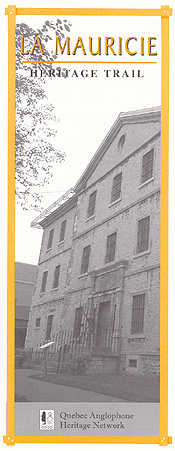
The bedrock of Canada’s industrial heritage runs through the valley of the Saint Maurice River.
Iron pots and stoves cast on its banks by French metalworkers in the early 18th century were the first fruits of this legacy. Water-driven turbines spinning in the current have yielded many more.
The valley’s forests and waterways were once the sole preserve of the Attikamek people. Merging with the Saint Lawrence midway between Quebec and Montreal, the St. Maurice River was a major fur-trade route in New France. Today, echoes of the Attikamek tongue may be heard in a smattering of place names, including Yamachiche, Lake Wapizagonke, Mékinak and Shawinigan.
Sawmills and lumber camps formed the kernels of permanent settlement north of Trois Rivières. British and American wood merchants seeking riches in the forest were early agents of industrial growth. Wood harvesting and processing still provide economic lifelines for most of the towns you'll see along this Trail.
The La Mauricie Heritage Trail identifies a sampling of communities and attractions from the mouth of the Saint Maurice to La Tuque. Though small in number, English-speaking Quebecers have long occupied a place in the valley’s industrial culture.
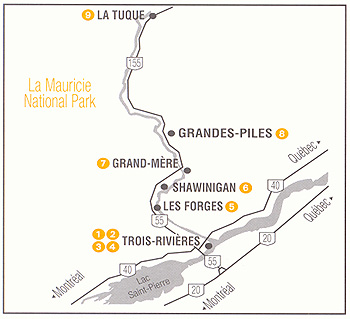 HOW TO GET THERE
HOW TO GET THERE
Old Trois Rivières is reached from Montreal or Quebec City by way of Autoroute 40. Visitors from the U.S. or Eastern Townships can take Autoroute 55 north to Autoroute 20, then Route 155 across the Laviolette Bridge. Exit 199 leads onto rue Notre Dame in the hub of the city’s historic quarter.
OLD TROIS RIVIÈRES
Historic gateway to a fur-trading empire, this centre of trade and production dates to 1634 when Samuel Champlain established a fort to protect Jesuit missionaries from Iroquois attack. Named for three branches of the Saint Maurice forming the river’s delta, Trois Rivières was the base of early journeys westward into Canada, notably those under Jean Nicolet, Pierre-Esprit Radisson and Médart Chouart-Desgroseilliers. It was the birthplace of Canada’s first Plains explorer, Pierre Gaultier de Varennes, Sieur de la Verendrye.
After Britain conquered New France in 1763, many English-speaking families came, settling in the city’s historic quarter bounded by Des Forges, Des Ursulines, Hart and St-Francois-Xavier streets. One prominent resident was Aaron Hart, a fur merchant and financier whose son Ezekiel became Lower Canada’s first Jewish legislator.
Canadian and American lumber companies began to log the St. Maurice valley and its tributaries in the 1840s. Sawmills sprang up across the region, while hundreds of ships bound for England and the U.S. sailed each year from Trois-Rivières’ busy port.
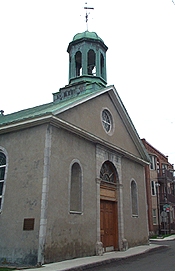 SAINT JAMES ANGLICAN CHURCH (Old Trois Rivières)
SAINT JAMES ANGLICAN CHURCH (Old Trois Rivières)
811 rue des Ursulines
Saint James Anglican Church was originally a chapel erected by French Récollet monks in 1703. The chapel served as court and prison after Britain’s occupation of the city in 1760. Anglicans acquired the church in 1823; it continues to serve a small but active English-speaking congregation.
Across the street stands the Ursuline Convent, first built in the late 1600s. It was used as a hospital for American revolutionary soldiers under General Montgomery during his invasion of Canada in 1775-76.
Dating to 1808, the old Anglican cemetery on the corner of St-Francois-Xavier and de Tonnancour streets is the city’s oldest Protestant burial ground. The Old Prison (1808-1811), a prominent relic of the British regime, is a visitor attraction operated by the Musée québécois de culture populaire on the corner of Laviolette and Hart streets.
Musée québécois de culture populaire (819) 372-0406
LUMBER TRADE (Old Trois Rivières)
Wealth created by the 19th century wood trade was largely controlled by English-speaking industrialists, as many striking Victorian mansions along Bonaventure, Radisson and Hart streets attest.
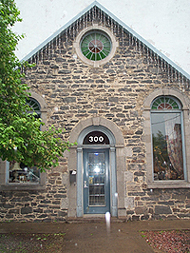 The Sociéte de conservation et d’animation patrimoine de Trois Rivières has erected a number of plaques in the area. Landmarks include the former Wesleyan church (1823) at 302 rue Bonaventure; lumber baron Alexander Baptist’s brick home (1879), 466 rue Bonaventure; and the French-colonial style Tonnancour Manor (1795), 864 rue des Ursulines.
The Sociéte de conservation et d’animation patrimoine de Trois Rivières has erected a number of plaques in the area. Landmarks include the former Wesleyan church (1823) at 302 rue Bonaventure; lumber baron Alexander Baptist’s brick home (1879), 466 rue Bonaventure; and the French-colonial style Tonnancour Manor (1795), 864 rue des Ursulines.
A HISTORY IN PAPER (Old Trois Rivières)
About the turn of the 20th century, Montreal- and Boston-based companies erected large pulp and paper mills to supply newsprint for American newspapers. These included the Canadian International Paper Co., the St. Lawrence Corp. and Consolidated Paper Corp.
The Pulp and Papers Industry Exhibition Centre overlooking the Saint Lawrence River in Harbourfront Park tells about the history of paper-making. Trois Rivières also developed important textiles manufacturing industries.
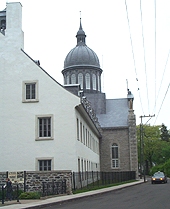 Three Rivers High School and Saint Patrick’s School, lying close to each other on Nicolas Perrot St. near the site of the former Wabasso cotton mill, continue to serve the city’s English-speaking community.
Three Rivers High School and Saint Patrick’s School, lying close to each other on Nicolas Perrot St. near the site of the former Wabasso cotton mill, continue to serve the city’s English-speaking community.
Trois-Rivières Tourist Bureau
1457 Notre Dame St. (800) 313-1123.
Pulp and Papers Industry Exhibition Centre
(819) 372-4633
Sociéte de conservation et d’animation patrimoine
(819) 378-1088
LES FORGES DU SAINT MAURICE
National Historic Site
Des Forges Boulevard traces one of the oldest roads in Quebec, built to link the historic Chemin du Roi with Canada’s first iron foundry. In operation for more than 150 years, the site was abandoned in 1883. Today, Les Forges is a major visitor attraction featuring ruins of the main blast furnace and a scale model of Canada’s first industrial community. Drive north along Boulevard Des Forges to reach it, or return to Autoroute 55, head north and take Exit 191.
François Poulin de Francheville, seigneur of Saint Maurice, opened the Forges in 1732. The complex was later expanded and taken over by the French government. Following Britain’s takeover of New France, the ironworks were run by a succession of English-speaking merchants, notably Mathew Bell, owner from 1796 to 1846. A range of small cast-iron objects such as stoves, containers, iron bars, ploughshare plates, anvils and hammers, were produced here.
Trois-Rivières merchant John McDougall bought the Forges in 1863 and made the foundry an important source of pig iron for the manufacture of train wheels.
Les Forges historic site: (819) 378-5116
SHAWINIGAN (pop. 30,000)
Cradle of Canada’s aluminium industry, this manufacturing centre was built above a 42-metre high waterfall at a place Attikamek Indians called achawénégane, meaning “portage along the crag.” Today, the lookout in Parc des Chutes offers a breathtaking view of the waterfalls.
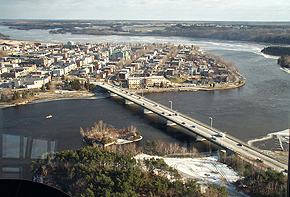 Settlement in Shawinigan began after Boston businessman John Joyce bought rights to develop the falls’ hydroelectric potential in 1897. The Shawinigan Water and Power Company began operations the following year. In 1899 the founder of North America’s aluminium industry, Charles Martin Hall, chose the site to build Canada’s first smelter.
Settlement in Shawinigan began after Boston businessman John Joyce bought rights to develop the falls’ hydroelectric potential in 1897. The Shawinigan Water and Power Company began operations the following year. In 1899 the founder of North America’s aluminium industry, Charles Martin Hall, chose the site to build Canada’s first smelter.
Over the next 50 years, Shawinigan prospered as an industrial centre and its electric power, paper, chemical and aluminium plants attracted chemists, engineers, millwrights and workers from around the world. Though nearly entirely French-speaking today, generations of English-speakers also made their home here. Shawinigan neighbourhoods still recall the prevailing social hierarchy: Maple Street with its prestigious houses was an English enclave populated by mill bosses; Saint-Marc Parish with its tenement dwellings in the shadow of Alcan’s chimneys was decidedly working-class.
Shawinigan High School on rue des Cedres is the cultural heart of the city’s remaining English community. Other interesting landmarks include the Shawinigan Falls Protestant Cemetery (1905); Saint Peter’s Catholic Church (l’Église Saint-Pierre) on Hemlock Street; the city’s ornate brick firehall (1921) on rue Champlain; and Jacques Plante Arena, named for the legendary hockey player and native son. Jean Chrétien, Canada’s prime minister from 1993 to 2004, grew up in Belgoville, a working-class neighbourhood inhabited by paper-mill employees.
The Cité de l’Energie museum on Melville Island tells about Shawinigan’s industrial heritage. Panoramic views await visitors at the top of the museum watchtower. Price of admission includes a ferry ride to the historic mill district, featuring Shawinigan Water and Power Co.’s first generating station and original headquarters of the Northern Aluminum Company (1899), forerunner of today’s Alcan.
Heritage Shawinigan: (819) 536-1184
Cité de l’energie (819) 536-8516
Website: www.citedelenergie.com
 GRAND-MÈRE (pop. 15,000)
GRAND-MÈRE (pop. 15,000)
New techniques for making wood pulp spurred growth of the pulp-and-paper industry in Quebec. In 1890 John Forman chose 30-foot high Grand-Mère Falls to build one of eastern Canada’s first pulpwood mills. The town get its name from Grandmother Rock, a natural geologic formation across from St Paul’s Catholic Church on 6th Ave.
Grand-Mère developed into an important forest-products centre under the Laurentide Pulp and Paper Company. Many English-speaking families were originally settled in company houses near the mill along 5th Ave. The first Town Hall occupied the prominent turreted stone building across from the mill.
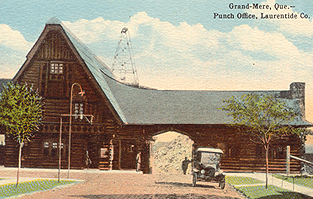 St. Stephen’s Anglican Church, a striking field-stone building on 5th Ave. was also built by the company, as was the Grand-Mere Inn nearby. Grand-Mère boasts one of Canada’s oldest golf clubs, established in 1910 by Laurentide’s general manager George Cahoon Jr.
St. Stephen’s Anglican Church, a striking field-stone building on 5th Ave. was also built by the company, as was the Grand-Mere Inn nearby. Grand-Mère boasts one of Canada’s oldest golf clubs, established in 1910 by Laurentide’s general manager George Cahoon Jr.
During the 1920s, the paper company pioneered the use of airplanes to prevent forest fires. The nearby community of Lac à la Tortue, where bush-plane pilots first trained, is considered the cradle of commercial aviation in Canada.
GRAND PILES
The village of Grandes Piles, overlooking a broad, calm stretch of the St-Maurice, was an important staging point for men and merchandise heading for lumber shanties upriver.
A sense of 19th century lumberjack life is nobly recreated in a unique roadside theme attraction called Village du Bûcheron. The site consists of a reconstructed lumber camp, complete with traditional outbuildings. Open from May till October.
Village du Bûcheron: Toll-free: 1 (877) 338-7895
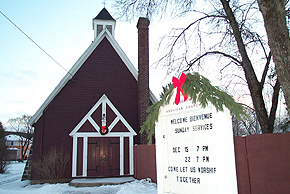 LA TUQUE (pop. 13,300)
LA TUQUE (pop. 13,300)
The stark beauty of the Laurentians and the hardy souls who inhabit this paper-mill town inspired Quebec troubadour Félix Leclerc to pen his famous coming-of-age novel, Pieds nus dans l’aube. Begun as a colony of lumberjacks and trappers, the settlement of La Tuque swelled in 1908 after the Brown Corporation built a mill and hydro-power dam. A number of English-speaking managers and their families formed the nucleus of La Tuque’s tiny English-speaking colony.
A number of homes and buildings along Beckler Street and rue St. Maurice (formerly, rue des Anglais) recall this Anglophone heritage: St. Andrew’s Anglican Church (1911), La Tuque High School and the Brown Community Club (1916), a company-built recreation centre declared an historic monument in 1988.
Société historique de La Tuque: (819) 523-6070
This guide is presented by the Quebec Anglophone Heritage Network. The Heritage Trail series is made possible by a grant from the Department of Canadian Heritage and Economic Development Canada. Space constraints preclude mention of all possible sites. Thanks to Roland Houde and Gerry MacDonald of Heritage Shawinigan and Bill Dousset of Trois Rivières. For more information call the QAHN office at (819) 564-9595; toll free within Quebec at 1 (877) 964-0409.![]()
![]()